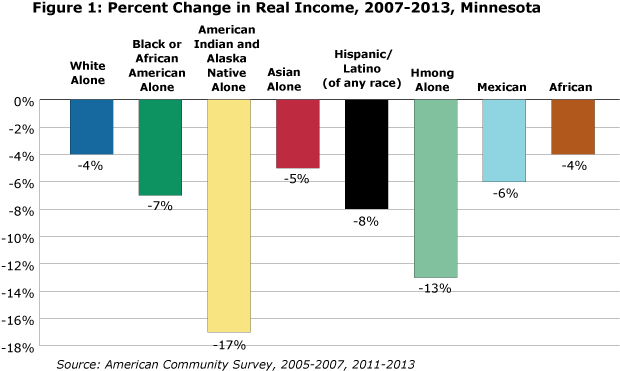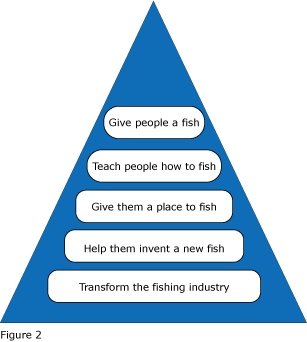by Bruce Corrie
December 2015
Bruce Corrie is the associate vice president of university relations and international programs at Concordia University in St. Paul. In this role, he works to build community and governmental relationships for the university and helps develop Concordia's international programs.
Minnesota is facing a demographic squeeze as baby boomers retire from the labor force and a smaller group enters. The group entering is composed of a much higher share of African, Latino, Asian and Native American (ALANA) populations than the group that is retiring.
ALANA communities have experienced a decline in their economic assets, such as income and homeownership, below that of 2007 levels. There is a need for policies and programs to grow these assets. For example, Figure 1 shows both the decline in real income during the period 2007-13 as well as important differences between and within ALANA communities.

The combined economic assets of the ALANA communities (including income, homes and businesses) are well over $20 billion, making them a key player in the Minnesota economy. This article offers some strategies to grow the economic assets of the ALANA communities. They draw on over three decades of my work as an economist, as well as numerous policy conversations and studies in the ALANA communities.
Before getting to specific proposals, it is important to recognize that our ALANA communities are positive "assets" that contribute to the region's future economic vitality. They are not communities that have "deficits" that need to be overcome. Changing policy perspectives from "deficit" to "asset" in relating to ALANA communities would shift the discourse from one tied to systems of oppression that de-value individual worth to one that emphasizes the promise and potential that these communities bring to our society.
Moreover, all too often policy discussions assume "one size fits all." Considering the ethnic and cultural diversity across ALANA communities and the varied background of their members, that assumption is a recipe for failure.
Successful policy actions must operate with cultural intelligence to be aware of differences within communities. For example within the South Asian community one will find people with advanced degrees from India and new immigrants from Myanmar who might not even have a high school education. Or we might assume that all small businesses face the same issues with lack of access to capital, but we fail to understand the diverse historical and institutional barriers to capital that ALANA firms face.
While success demands customized policies, a comprehensive, long-term and coordinated ALANA business and workforce strategy also is crucial.
Figure 2 provides a template to think about Minnesota's economic development infrastructure. Currently, Minnesota's economic development efforts for ALANA communities are all too often in the "giving a fish" or "teaching how to fish" areas. More attention is needed to develop strategies further downstream, including enabling ALANA business startups, entrepreneurship and expansion of existing businesses.

Finally, while these thoughts focus on the ALANA community, we cannot ignore the disenfranchisement of low-income, low-skilled and poorly-educated Minnesotans in other communities. Their success is also critical for Minnesota's future.
Below are some suggested strategies.
Financial assets are critical to large segments of the community that are either unbanked or have negligible financial assets. This in turn impacts household survival in tough times and the capital needed for business formation or skill development.
I offer some strategies in below to grow these financial assets.
There is a lot of policy discourse on closing the educational achievement gap. A recent report by the National Research Council points to the importance of "deeper learning" methods to improve STEM (science, technology, engineering and mathematics) education and develop 21st century skills.
Large percentages of ALANA students are coming out of school poorly prepared to work in the new economy where STEM skills will determine job and career success. Deeper learning strategies that engage students through interactive, applied and team learning have been shown to be successful and should be built upon.
The learning environment of the ALANA child is not always culturally intelligent, and this serves as a barrier to educational success. So also is the absence of ALANA teachers and professors in the classroom. Finally, affordable post-secondary education is a top priority. The strategies below are aimed at meeting these challenges.
Minnesota needs to provide resources that allow people stuck in low-paying, low-skilled jobs to retool and transition into higher-paying jobs that pay at least a living wage. This is not an insurmountable challenge and can be developed through a flexible skill-building program based at the community level and delivered with community partners, such as the Emerging Workforce Coalition. At the same time we need to focus on retaining high-skilled workers and to develop policies to recruit and retain foreign workers.
We are also plagued by underemployment of immigrants with foreign credentials that are not appropriately recognized in Minnesota. There are ways, however, to overcome this challenge, such as through credential verification services. ALANA workers also face what is termed the glass or bamboo ceiling. They are not represented in the top leadership positions within organizations even though they have advanced degrees and credentials. The strategies below will help solve these challenges.
Finally, there is a vibrant entrepreneurial energy in ALANA communities. This is reflected in the latest data from the Survey of Business Owners (2012), which shows ALANA firms grew faster in number, sales, jobs and payroll than firms in Minnesota overall. But despite this growth, the average size of these firms remains much lower than other firms in Minnesota. There is a need to grow these businesses so that they strengthen the ALANA community and overall economy, especially because they tend to employ ALANA workers and build the community's economic base. Below are some strategies to grow these firms.
Minnesota's vibrant and diverse ALANA population is a strong asset as we enter a period of workforce challenges. But we need strategies that allow us to tap this asset more effectively than we have in the past. The above strategies will move us in that direction and help build a state economy that is vibrant, inclusive and globally competitive.